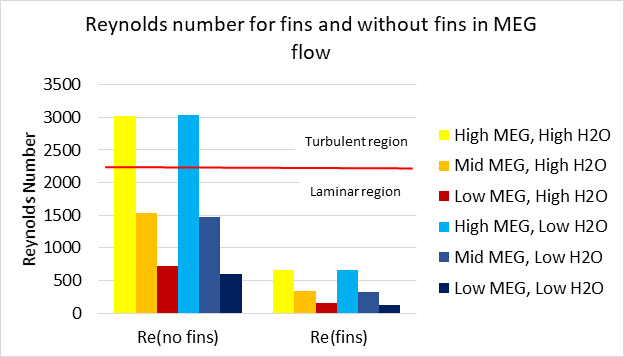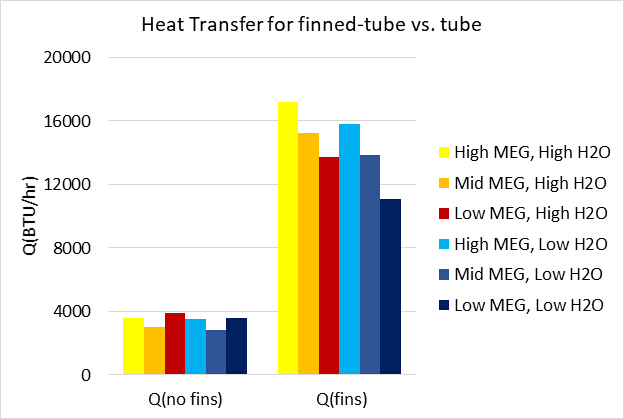בדיקת יעילות העברת החום של מחליף חום פין-צינור
Overview
מקור: מייקל בנטון וקרי מ. דולי, המחלקה להנדסה כימית, אוניברסיטת לואיזיאנה סטייט, באטון רוז', לוס אנג'לס
מחליפי חום מעבירים חום מנוזל אחד לנוזל אחר. סוגים מרובים של מחליפי חום קיימים כדי למלא צרכים שונים. כמה מן הסוגים הנפוצים ביותר הם מחליפי פגז וצינורות מחליפי לוחות1. מחליפי חום מעטפת וצינור להשתמש במערכת של צינורות שדרכו נוזל זורם1. קבוצה אחת של צינורות מכילה את הנוזל לקירור או מחומם, בעוד הסט השני מכיל את הנוזל שיספוג חום או ישדר אותו1. מחליפי חום צלחת להשתמש מושג דומה, שבו לוחות מחוברים מקרוב יחד עם פער קטן בין כל אחד עבור נוזל לזרום1. הנוזל הזורם בין הצלחות מתחלף בין חם לקור, כך שהחום יעבור אל או מחוץ לנחלים הדרושים1. מחליפינים אלה יש שטחים גדולים, ולכן הם בדרך כלל יעילים יותר1.
המטרה לניסוי זה היא לבחון את יעילות העברת החום של מחליף חום של צינור פין (איור 1) ולהשוות אותו ליעילות התיאורטית של מחליף חום ללא סנפירים. הנתונים הניסיוניים יימדדו עבור שלושה קצבי זרימה שונים של מונואתילן גליקול (MEG). ייעשה שימוש בשני תעריפי זרימת מים שונים עבור כל קצב זרימת MEG. בשיטת עלילת וילסון, מקדמי העברת החום ייקבעו מהנתונים הניסיוניים. בנוסף, מספר ריינולד וכמות החום המועברת יושוו לזרימה עם ובלי הסנפירים כדי להעריך את יעילות העברת החום.

איור 1: מחליף חום פין-צינור. 1) טמפרטורת שקע MEG 2) טמפרטורת הכניסה של מים 3) טמפרטורת הכניסה MEG 4) טמפרטורת שקע מים 5) מטר מים 6) זכוכית / צילינדר הצטברות MEG.
Principles
מחליפי חום מעבירים חום בין שני נוזלים או יותר. המחליפים משתמשים במינים זורמים בחלל נפרד מזרם מנוגד המספק חום. ניתן להוסיף סנפירים לאזור הזרימה כדי להקל על העברת חום נוספת, שכן הם מגדילים את שטח הפנים הזמין להעברה. הסנפירים הנוספים מקטינים את האזור שדרכו זורם המין ומספקים יותר משטחים שעליהם יכולות להיווצר שכבות גבול, וכתוצאה מכך זרימה פחות סוערת. ככל שזרימה פחות סוערת, שכבת הגבול הגדולה יותר תהיה לה. שכבת גבול מעכבת העברת חום, כך שעם זרימה פחות סוערת פחות חום מועבר. כאשר שכבת הגבול היא למינאר, יש מעט מאוד ערבוב.
הקשר בין האזור שדרכו חום יכול לזרום לבין מקדם העברת החום משמש לחישוב החום הכולל המועבר. קשר גומלין זה מחושב באמצעות משוואה 1:
 (1)
(1)
כאשר Q מועבר חום (Btu/hr), U הוא מקדם העברת חום כולל, A הוא אזור שדרכו מועבר חום (רגל2), ΔTLM הוא הפרש הטמפרטורה הממוצע הלוגריתמי.
משוואת מקדם העברת החום הכוללת היא:
 (2)
(2)
כאשר Ab הוא שטח הפנים של הצינור הפנימי החשוף, Af הוא שטח הפנים של הסנפירים,LM הוא הפרש השטח הממוצע הלוגריתמי, A הוא שטח הפנים של הצינור (o = בחוץ, i = בפנים), עובי Δx של הצינור, k הוא מוליכות תרמית של הצינור, h = מקדם העברת חום בודד. (o = בחוץ, i = בפנים)
שיטת העלילה של וילסון משתמשת בנתונים ניסיוניים כדי למצוא את UoAo מאיזון אנרגיה טיפוסי בזרימת MEG ולתוות את ההדדיות שלה ל- 1/Re0.8 של הצינור הפנימי. על ידי התאמת קו ישר ומציאת יירוט y, הקשור למקדם העברת החום ומתואר בשתי המונחים הראשונים מימין למשוואה לעיל. משוואת יעילות סנפיר מלבנית טיפוסית של פרופיל אורך משמשת כמשוואה השנייה לפתרון מקדם העברת החום ויעילות הסנפיר על-ידי מזעור סכום הריבועים של פונקציה אובייקטיבית. שיטה זו חלה על תנאי זרימת MEG עם קצבי זרימת מים משתנים.
כדי לחשב את מקדם העברת החום, נעשה שימוש במספר ריינולדס, שניתן על-ידי המשוואה הבאה:
 (3)
(3)
כאשר G הוא מהירות המסה של זרימת הנוזלים, D הוא קוטר הצינור שבו הנוזל זורם (Deq, הקוטר המקביל יחליף D לחישובים עם סנפירים), μ הוא הצמיגות של הנוזל. משוואת יעילות סנפיר עבור סנפיר פרופיל מלבני אורך היא:
 (4)
(4)
כאשר m הוא √(2h/kt), h הוא מקדם העברת חום, k הוא מוליכות תרמית של הצינור, t הוא עובי של סנפיר, ו b הוא גובה הסנפיר.
Procedure
1. קביעת קצב התחלה וזרימה
- פתח את שסתום המטען הממוקם מתחת לגנרטור הקיטור.
- התחל את היחידה, ואפשר 15 דקות עבור קיטור להתחיל להרכיב.
- חישוב קצב זרימת המים
- הפעל שעון עצר ונטר את מד המציג את נפח המים.
- עצור את השעון לאחר 30 s ורשום את הנפח הכולל של מים המוצגים על המד.
- חלק את נפח המים עד כדי לקבוע את קצב הזרימה נפחית.
- הקלט את קצב זרימת MEG מד הזרימה.
- שים לב לטמפרטורה מהתרמיקופלים, ורשום את הערכים.
2. שינוי קצב הזרימה וכיבוי
- כדי לאסוף נתונים עבור 6 ריצות שונות, הגדר את קצב זרימת המים לקצב זרימה גבוה או נמוך והפעל אותו עם קצב זרימה גבוה, בינוני או נמוך של MEG.
- לעיון, נעשה שימוש בשיעורי הזרימה הקודמים: 0.0439, 0.0881 ו- 0.1323 גל/שניה עבור קצבי הזרימה הנמוכים, הבינוניים והגבוהים של MEG, בהתאמה.
- כבעבר, תיעד את קצבי הזרימה הנפחיים ואת הפרשי הטמפרטורה בתרמי-סקופ לכל ריצה.
- כשתסיים, כבה את הכלי.
- סגור את השסתומים כדי לעצור את זרימת הקיטור, מונואתילן גליקול ומים.
- כבה את המתג הראשי.
3. חישובים
- השתמש במשוואה 1 כדי לחשב את החום הכולל שהועבר, Q, כאשר הפרש הטמפרטורה נקרא מהתרמיקופלים (התקנים המשמשים למדידת טמפרטורה) והממדים הפיזיים הידועים של מחליף החום (נמצא במדריך למשתמש עבור היחידה המופעלת). הבדלי הטמפרטורה ניתן לקחת מתוך קריאות הטמפרטורה של כל ריצה.
- חשב את החום שהועבר עבור כל גירסת ניסיון ייחודית והשתמש בשיטת התוויית וילסון כדי למצוא את מקדמי העברת החום עבור שלושת קצבי זרימת MEG.
- השווה את החום המחושב שהועבר ואת מספר ריינולדס לערכים תיאורטיים של מחליף החום ללא סנפירים.
Results
מחליף החום של הצינור לא הגיע לזרימה סוערת(איור 2). הסנפירים מספקים משטחים נוספים שעליהם נוצרות שכבות גבול, כידוע באמצעות תורת למינאר וזרימה סוערת. אם הנוזל אינו במהירות מספקת, הנוזל לא יגיע למערבולת. שכבות הגבול בין הסנפירים חופפות באזור למינאר, כך שהנוזל יישאר למינארי.

איור 2: מספרי ריינולדס עבור כל הגדרה.
כמות החום שהועברה, Q, בצינורות עם ובלי סנפירים בקצבי זרימה שונים של MEG הושוותה(איור 3). התוצאות מראות כי צינור פין מעביר יותר חום מאשר צינור ללא סנפירים באותו תנאי הפעלה. בניסוי זה, הסנפירים בבירור שיפרו את העברת החום. הסיבה לכך היא העברת חום יעילה יותר כאשר יש שטח פנים גדול יותר זמין. מחליף החום של הצינור הת'ים העביר יותר חום(איור 3),למרות מספר ריינולדס הנמוך יותר(איור 2).

איור 3: החום מועבר בין מחליפים עם ובלי סנפירים בכל קצב זרימה.
Application and Summary
מחליפי חום משמשים במגוון תעשיות, כולל חקלאות, ייצור כימי, ו- HVAC. המטרה לניסוי זה הייתה לבחון את יעילות העברת החום של מחליף חום פין-צינור ולהשוות אותו ליעילות התיאורטית של מחליף חום ללא סנפירים. נתונים ניסיוניים נמדדו עבור שלושה קצבי זרימה שונים של מונואתילן גליקול (MEG) ושני קצבי זרימת מים ייחודיים עבור כל קצב זרימת MEG בשימוש. מספרו של ריינולד נקבע לזרימה עם ובלי הסנפירים ושימש לחישוב מקדם העברת החום, שטח הפנים ויעילות הסנפיר עבור כל הרצת ניסיון ייחודית. נתונים אלה שימשו להערכה אם זרימה סוערת אפשרית ללא הסנפירים ותחתיו מתרחשת מערכת של תנאי ניסיון העברת החום ביותר. הצינורות המפונים לא הגיעו לזרימה סוערת. התוצאות הראו כי צינור סנפיר יעביר יותר חום מאשר צינור ללא סנפירים באותו תנאי הפעלה כי זרימת MEG דרך מחליף החום לא תגיע למערבולת.
בענף החקלאות, מחליפי חום משמשים בעיבוד של סוכר ואתנול2. שני מוצרים אלה מעובדים לתוך מיץ, אשר חייב להיות מחומם כדי להיות מעובד עוד יותר2. מחליפי חום משמשים לחימום המיצים להבהרה2. לאחר המיצים מעובדים לתוך סירופים זוגיים, חימום נוסף עם מחליפים יש צורך להמשיך עיבוד וליצור מולסה2. מולסה מקורר באמצעות מחליפי חום, ולאחר מכן ניתן לאחסן אותו לעיבוד מאוחר יותר2.
מערכות חימום, אוורור ומיזוג אוויר, המכונות יחד HVAC, כולן עושות שימוש במחליפי חום3. מיזוג אוויר ביתי ויחידות חימום לעשות שימוש מחליפי חום3. במסגרות גדולות יותר, מפעלים כימיים, בתי חולים ומרכזי תחבורה כולם עושים שימוש במחליף חום דומה HVAC, בקנה מידה גדולבהרבה 3. בתעשייה הכימית, מחליפי חום משמשים לחימום וקירור מגוון גדול של תהליכים4. תסיסה, זיקוק ופיצול כולם עושים שימוש מחליפי חום4. תהליכים נוספים כמו תיקון וטיהור דורשים מחליפי חום4.
References
- Types of Heat Exchangers." Types of Heat Exchangers. N.p., n.d. Web. 19 Jan. 2017.
- Heat exchangers for sugar factories and distilleries." Heat exchanger for sugar and ethanol industry. N.p., n.d. Web. 19 Jan. 2017.
- Biotechnology and green chemistry heat exchangers." Heat exchanger for green chemical industry. N.p., n.d. Web. 19 Jan. 2017.
- Heat exchangers for heating and cooling." Heat exchangers for district heating, cooling and HVAC. N.p., n.d. Web. 19 Jan. 2017.
Tags
Skip to...
Videos from this collection:

Now Playing
בדיקת יעילות העברת החום של מחליף חום פין-צינור
Chemical Engineering
17.9K Views

שימוש במייבש מגשים לחקר העברת חום קונבקטיבית ומוליכת
Chemical Engineering
44.0K Views

צמיגות של פרופילן גליקול פתרונות
Chemical Engineering
33.1K Views

פורוסימיטריה של אבקת סיליקה אלומינה
Chemical Engineering
9.6K Views

הדגמת מודל חוק הכוח באמצעות שחול
Chemical Engineering
10.2K Views

בולם גז
Chemical Engineering
36.8K Views

שיווי משקל נוזלי אדים
Chemical Engineering
89.4K Views

ההשפעה של יחס ריפלוקס על יעילות זיקוק מגש
Chemical Engineering
77.9K Views

יעילות של מיצוי נוזלי נוזלי
Chemical Engineering
48.5K Views

כור פאזה נוזלית: היפוך סוכרוז
Chemical Engineering
9.7K Views

התגבשות חומצה סליצילית באמצעות שינוי כימי
Chemical Engineering
24.3K Views

זרימה חד-פאזית ותלת-פאזית בכור מיטה ארוז
Chemical Engineering
19.0K Views

קינטיקה של תוספת פילמור לפולידימתילסילוקסן
Chemical Engineering
16.2K Views

כור קטליטי: הידרוגנציה של אתילן
Chemical Engineering
30.5K Views

הערכת העברת החום של ספין וצינה
Chemical Engineering
7.4K Views
Copyright © 2025 MyJoVE Corporation. All rights reserved